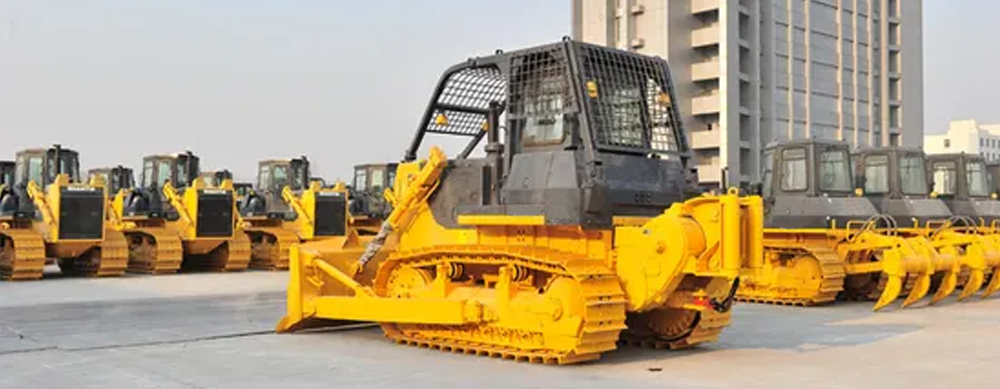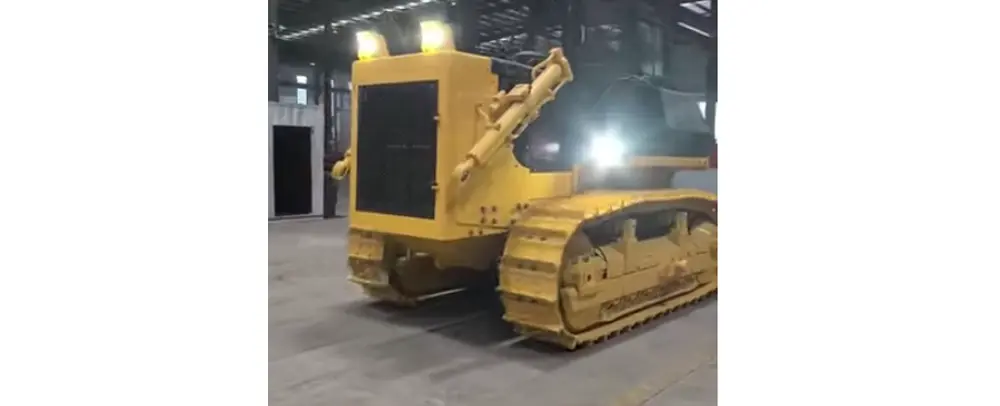Universal bulldozers are highly adaptable and powerful machines. They feature a broad, heavy-duty blade at the front, capable of moving large volumes of earth, debris, or snow with ease. The blade can be adjusted in multiple angles and positions to meet various working demands. Mounted on a robust chassis, these bulldozers have excellent stability and traction, allowing them to operate on different terrains, from soft mud to rocky ground. Powered by potent engines, they deliver the force required for heavy-duty tasks. The operator's cab is ergonomically designed, providing comfort and clear visibility, which is crucial for precise and efficient operation.
| Pictures |
|
|
|
|
| General parameters | ||||
| Model | SEM816D | 818F | SEM822D | 824F |
| Operating weight (kg) | 16900 | 16860 | 24000 | 23730 |
| Climbing capacity (°) | 30 | 30 | 30 | 30 |
| Ground Specific Pressure (kPa) | 56 | 62 | ||
| Power range | 120-220kW | 120-220kW | 120-220kW | 120-220kW |
| Power Type | Fuel | Fuel | Fuel | Fuel |
| Engine | ||||
| Model | WP7G200E472 | WP10HG270E471 | ||
| Flywheel power (kW) | 140 | 147 | 183 | 211 |
| Rated speed (r/min) | 2200 | 2200 | ||
| Emission standard | Euro 4 | Euro 4 | ||
| Dimension | ||||
| Track plate width (mm) | 510 | 510 | 560 | 560 |
| Track Ground Length (mm) | 2515 | 2948 | ||
| Minimum Turning Radius (mm) | 3700 | 4215 | ||
| Minimum Ground Clearance (mm) | 400 | 400 | ||
| Transmission | ||||
| Type | Dual, closed, electrically controlled hydrostatic transmission | Dual, closed, electrically controlled hydrostatic transmission | ||
| Steering Brake | Wet Multi-Plate Brakes | Wet Multi-Plate Brakes | ||
| Number of supporting wheels (single side) (pcs) | 6 | 6 | 7 | 7 |
| Number of sprockets (single side) (pcs) | 2 | 2 | 2 | |
| Travel speed 1st gear (forward/reverse) (km/h) | Continuously variable 0-10 | 0~10 | ||
| Number of track plates | 37 | 40 | ||
| Shoveling device | ||||
| Type | Half-U Shovel/Straight Tilt Shovel | Half-U Shovel/Straight Tilt Shovel | Half-U Shovel/Straight Tilt Shovel | Half-U Shovel/Straight Tilt Shovel |
| Shovel capacity (m³) | 4.3/3.5 | 6.4/5.8 | ||
| Spade width | 3167/3460 | 3605/3700 | ||
| Spade Height (mm) | 1240/1165 | 1520/1510 | ||
| Maximum lifting height (mm) | 1005 | 1140 | ||
| Maximum depth of cut (mm) | 410 | 570 | ||
| Maximum tilt (mm) | 487/539 | 520/540 |

1. The chassis of a universal bulldozer is a massive, heavy-duty structure, usually made of thick-gauge steel. It's designed to provide the utmost stability and support for the entire machine.
2. Blade: The blade is the most prominent feature of a bulldozer. It's a broad, flat, and thick metal structure located at the front of the machine.
3. Adjustment Mechanism: The blade can be adjusted in multiple ways. It can be tilted up or down to control the depth of cut and the height of the material being pushed.
4. The track system is a vital component that gives bulldozers their excellent traction and stability. The tracks are made up of a series of metal links connected by pins and rollers.
5. Engine: Universal bulldozers are typically powered by large diesel engines. These engines are chosen for their high-torque output, which is essential for the heavy-duty work of pushing large amounts of material.
6. Transmission: The transmission system is responsible for transferring the engine's power to the track system. There are different types of transmissions available, including manual, semi-automatic, and fully-automatic.
7. The operator's cab is designed to provide a comfortable and functional workspace. It's usually elevated to give the operator a good view of the blade and the work area.

1. Consider the volume and nature of material you need to move. For large-scale earth-moving projects like construction site grading or land-clearing, a bulldozer with a wide and deep blade is preferable.
2. Calculate the force required to move the materials in your work area. The bulldozer's engine power, measured in horsepower, and its tractive effort are crucial.
3. For soft and muddy terrains, a bulldozer with wide tracks and good flotation is essential. The track shoes should have a design that provides sufficient traction without sinking.
4. In confined construction sites or areas with limited access, a more compact bulldozer with a small turning radius is beneficial.
5. A reliable and efficient engine is the heart of a bulldozer. Look for well-known engine brands with a reputation for durability and fuel efficiency.
6. The hydraulic system controls the blade's movement. A high-quality hydraulic system with a sufficient flow rate and pressure is necessary for smooth and precise blade adjustments.
7. The operator's cab should be comfortable and ergonomic. It should have a seat that can be adjusted for different operator sizes and working positions.
8. Clear visibility of the blade and the work area is crucial. The cab should have large windows on all sides, and the design should minimize blind spots.

Universal bulldozers are equipped with a heavy-duty blade that allows them to move large volumes of earth, debris, and other materials with ease.
The blade of a universal bulldozer can be adjusted in multiple ways. It can be tilted up or down to control the depth of the cut and the height of the material being pushed.
With a well-designed track system, universal bulldozers have excellent traction and stability. The tracks provide a large contact area with the ground, allowing the machine to operate on various terrains, including soft mud, sandy areas, and rocky ground.
Built to withstand harsh working conditions, universal bulldozers have a sturdy chassis and components. The frame is made of heavy-duty steel to support the weight of the machine and the forces exerted during operation.
The operator's cab of a universal bulldozer is designed with comfort and functionality in mind. It provides good visibility of the blade and the work area through large windows and minimal blind spots.

